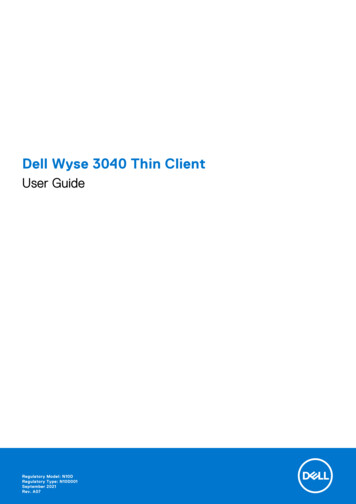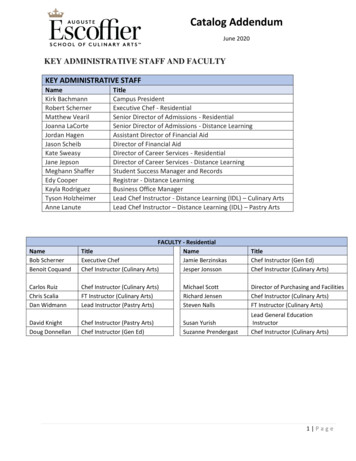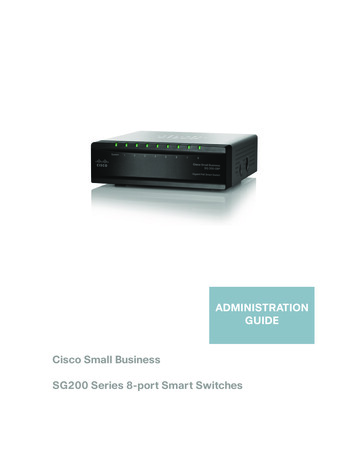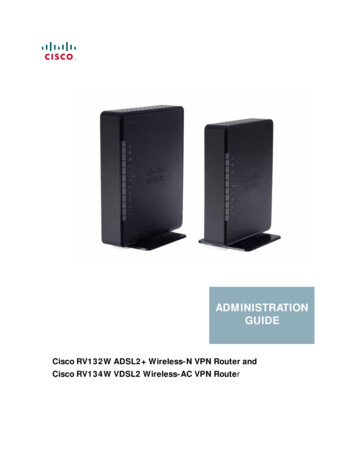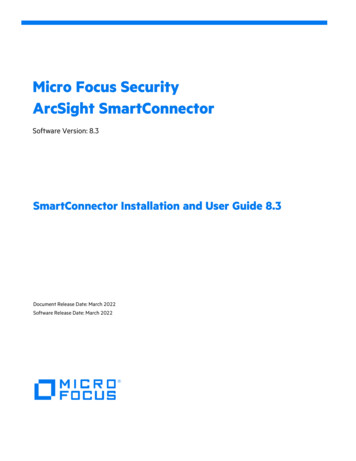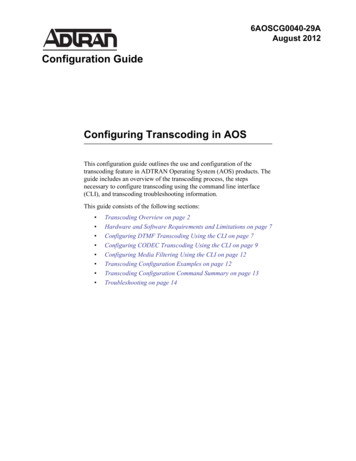
Transcription
6AOSCG0040-29AAugust 2012Configuration GuideConfiguring Transcoding in AOSThis configuration guide outlines the use and configuration of thetranscoding feature in ADTRAN Operating System (AOS) products. Theguide includes an overview of the transcoding process, the stepsnecessary to configure transcoding using the command line interface(CLI), and transcoding troubleshooting information.This guide consists of the following sections: Transcoding Overview on page 2Hardware and Software Requirements and Limitations on page 7Configuring DTMF Transcoding Using the CLI on page 7Configuring CODEC Transcoding Using the CLI on page 9Configuring Media Filtering Using the CLI on page 12Transcoding Configuration Examples on page 12Transcoding Configuration Command Summary on page 13Troubleshooting on page 14
Transcoding OverviewConfiguring Transcoding in AOSTranscoding OverviewTranscoding is a method of translating media types, such as between RFC 2833 events and in-banddualtone multifrequency (DTMF) signals or different voice coder-decoders (CODECs). SIP transmissionstake place in the Voice over IP (VoIP) network, and include an SDP exchange over a device that links theoffer and answer requests from the SIP endpoints attempting to connect a call. In AOS, the device thatpasses the offer and answer requests from the SIP endpoints is the AOS device acting as a session bordercontroller (SBC). In transcoding, the SBC operates as a translator for SIP devices that are attempting aconnection, but are using different media types, by translating one media type to another to allow thecommunication to succeed. In addition, the transcoding feature allows the SBC to filter out certain media(video) from SDP messaging. The place of the AOS SBC device in the VoIP network, and the operation ofthe transcoding feature, are described in Figure 1.1: Offer2: Translated OfferAOS SBC DeviceSIP Endpoint4: Translated AnswerSIP Endpoint3: AnswerFigure 1. AOS SBC and Transcoding in the VoIP NetworkTranscoding OperationWhen a SIP call is initiated, an SDP offer is made to the answering SIP device. This offer is passed throughthe SBC and along to the answering SIP device. The answering SIP device then responds with an SDPanswer, which is in turn passed through the SBC to the initial offering SIP device. If there is a discrepancybetween the media types (DTMF or CODEC) used by either SIP device, the SBC recognizes the mismatchand attempts to transcode the media type so that communication between the two SIP endpoints can occur.In order to transcode the media types between the SIP endpoints, the SBC must be in the media path. Itanchors both media streams between the SIP endpoints, and begins the transcoding process after receivingthe media capabilities of the endpoints in the SDP offer and answer. For the transcoding process to work,the SBC must be configured with media anchoring, a feature of AOS products used to force RealtimeTransfer Protocol (RTP) packets to ingress and egress the local network through the AOS device, thusanchoring the RTP stream to interfaces on the AOS device. For more information about media anchoring,and its configuration, refer to the configuration guide Configuring Media Anchoring in AOS, availableonline at https://supportforums.adtran.com.There are two types of transcoding supported by the AOS SBC: DTMF interworking and CODECtranscoding. DTMF interworking is configured on a global level within the AOS device, as well as on eachSIP endpoint that connects to the AOS device. When a DTMF relay mismatch occurs between an SDPoffer and corresponding answer, the SBC transcodes between the two formats to allow the call to becompleted. In-band and RFC 2833 named telephone events (NTE) are the only DTMF relay methods thatare acceptable as a transcoding source or target. In addition, if an answering SIP endpoint is configured forNTE with a payload type of X, and an offer is destined for the endpoint with an NTE payload type Y,transcoding is not used by the SBC, but rather, the SBC sends the offer with payload type Y to theanswering endpoint. This method saves transcoding resources on the SBC.2Copyright 2012 ADTRAN, Inc.6AOSCG0040-29A
Configuring Transcoding in AOSTranscoding OverviewCODEC transcoding is also configured on a global level within the AOS device, as well as on each SIPendpoint that connects to the AOS device. CODEC lists can be configured on SIP endpoints, which affectthe filtering of CODECs in both the transmit and receive directions, or to a specific traffic direction. Forexample, you can allow any CODEC to flow into the SBC and restrict transmissions to a single CODEC,transcoding as necessary. In addition, you can specify that any CODEC is allowed to flow to or from theSIP endpoint.Any CODECs that are added in the translated SDP offer are appended to the end of the CODEC list toprevent transcoding when it is unnecessary (if the answering device chooses a higher prioritynon-transcoded CODEC first). If the SBC device receives an offer that does not contain any compatiblesource CODECs, then transcoding is not possible. Table 1 describes the source and target CODECssupported by AOS devices. Note that transcoding between the varieties of G.729 is not supported; rather, ifany G.729 CODEC is offered, it can pass through but is not transcoded. In addition, note that transcodingto or from T.38 is not supported, but that companding type conversion is supported (G.711u to G.711a andvice-versa).Table 1. Supported Source and Target 711uG.729G.729aG.729bG.729aG.729abG.729abWhether DTMF or CODEC transcoding is being employed, a digital signal processor (DSP) is required.Software transcoding for devices without a DSP is not supported. Because transcoding uses the DSP, everycall that requires transcoding consumes exactly two DSP channels. These channels do not have to becontiguous, but they must both reside on the same DSP; for example, a single channel on DSP 1 and asingle channel on DSP 2 is not sufficient to transcode. The two channel requirement is true regardless ofthe source and target CODECs or the DTMF relay methods used, but two channels are sufficient fortranscoding both CODEC and DTMF relays simultaneously on the same call.Table 2 outlines the supported CODECs, DTMF relay methods, transcoding functions, and the requiredDSP channels for each transcoding operation.In-band DTMF signaling over G.729 is supported, but it is not recommended.6AOSCG0040-29ACopyright 2012 ADTRAN, Inc.3
Transcoding OverviewConfiguring Transcoding in AOSTable 2. Supported Transcoding ScenariosOfferCODECg711uOffer DTMFIn-Band No2Copyright 2012 ADTRAN, Inc.6AOSCG0040-29A
Configuring Transcoding in AOSTranscoding OverviewTable 2. Supported Transcoding Scenarios (Continued)OfferCODECg729 (any)Offer g729(same)AnswerDTMFTranscoding Resource ConsiderationsWhen the SBC receives an SDP offer, it must decide if transcoding is necessary or not, regardless ofwhether the offer comes from the session originator or the session destination. If the offer containscompatible CODECs based on the offerer’s inbound CODEC restrictions, then transcoding is an option. Ifthe offer does not already contain all of the supported target CODECs (see Table 1 on page 3), then theSBC can add additional CODECs to the offer as long as the answering device’s outbound CODECrestrictions allow it. If at this point, a transcoding opportunity exists, the SBC attempts to reservetranscoding resources. If resources are available, the SBC appends available transcoding CODECs to theoffer and passes it along. If resources are not available, the SBC does not add any additional CODECs tothe offer. This allows the call to complete, assuming there are CODEC compatibilities between the offeringand answering devices. The transcoding resources for the call are reserved at the reception of the SDPoffer. If the answering device has chosen a CODEC that was not present in the original offer, that means ithas selected a CODEC that was added to the offer by the SBC, and transcoding takes place. If transcodingis either unnecessary or not possible, the resources allocated for the call are freed and can be used by otherparts of the system. If transcoding does take place, the resources will not be freed for the duration of thecall, even if the session media is altered in such a way that transcoding is no longer necessary. Figure 2 onpage 6 outlines the transcoding resource allocation process in the AOS SBC.6AOSCG0040-29ACopyright 2012 ADTRAN, Inc.5
Transcoding OverviewConfiguring Transcoding in AOSOffer Resource AllocationReceive OfferAnswer Resource AllocationReceive AnswerRemove Offerer inboundCODEC restrictions odingYesNoOffer urcesNoFreetranscodingresourcesNoRemove Answereroutbound CODECrestrictions fromofferSend Offerto AnswererAdd transcodingCODEC to offerat lowest priorityRemove Offereroutbound CODECrestrictions fromanswerSend Answerto OffererFigure 2. SBC Transcoding Resource AllocationResource allocation for transcoding purposes is done dynamically following the process outlined above. Inaddition, if a SIP INVITE message is received by the SBC that does NOT contain an SDP offer,transcoding resources are not reserved. The SBC only attempts to reserve transcoding resources when anSDP offer is received. Once the SBC receives the SDP offer, it must determine the destination SIPendpoint (answering endpoint). If the offer and the answering device’s outbound CODEC restrictions donot match, meaning that transcoding is necessary, then transcoding resources are required. If theseresources are not available, the call is rejected with a 503 (Service Unavailable) error. Should this eventoccur, a warning event is created in the event log. If this event occurs when transcoding is a possibility, butnot absolutely required, and insufficient resources are available, a debug message is logged instead.A 503 error occurs only if the transcoding resources are not available AND transcoding isenabled. If transcoding is not enabled, and the offer and the answering device’s outboundCODEC restrictions do not match, a 415 (Unsupported Media) error occurs.Call Throughput and Call Delay ConsiderationsIn addition to using SBC resources, transcoding can affect the call throughput and the call delay in the SBCnetwork. Keep in mind the following considerations to properly implement transcoding on your networkwith minimal undesired effects.6Copyright 2012 ADTRAN, Inc.6AOSCG0040-29A
Configuring Transcoding in AOSHardware and Software Requirements and LimitationsThe maximum call throughput for transcoded calls is directly proportional to the number of DSP channelsavailable on your AOS SBC. Every transcoded call requires two DSP channels, which limits the maximumcall volume on the SBC device to half of the number of DSP channels if every call is transcoded. Inaddition, because transcoding requires media anchoring to be enabled, and many network configurationsdepend on voice quality monitoring being enabled, the overhead of both features causes the SBC callcapacity to be reduced to 60 percent of normal. This penalty is incurred as long as transcoding is enabled,even if no calls are transcoded because 60 percent is the upper bound for an AOS SBC device with mediaanchoring enabled (regardless of whether transcoding is enabled).In addition, transcoding adds a minimum call path delay of 60 ms. This delay is the same for all transcodedstreams, regardless of the CODEC or DTMF relay mode used.Hardware and Software Requirements and LimitationsIn addition to the resource and network considerations discussed in Transcoding Overview on page 2, thetranscoding feature is only supported on specific AOS SBC platforms. For a complete list of supportedplatforms, refer to the AOS Feature Matrix, available online at https://supportforums.adtran.com.The number of supported simultaneous transcoding calls on a specific platform will depend on the numberof DSP channels available on that platform.Software transcoding for devices without a DSP is not supported in AOS firmware release R10.4.0.Media anchoring must be enabled for transcoding to function properly. For more information about mediaanchoring, and its configuration, refer to the configuration guide Configuring Media Anchoring in AOS,available online at https://supportforums.adtran.com.The G.711 CODEC is the only recommended CODEC for use with in-band DTMF signaling, but otherlower bit-rate CODECs (for example, G.729) are supported.When DTMF interworking is configured on a SIP endpoint, it does not restrict DTMF relay methods forthe endpoint. For example, an endpoint configured for NTE can still send offers and answers to the SBCusing in-band DTMF; however, the SBC will only send NTE offers to the endpoint. In addition,transcoding does not occur between different NTE payload types.Because you can configure a CODEC list to support any CODEC (using the any keyword), the string anycannot be used as a CODEC list name.Transcoding of T.38 is not supported. In addition, transcoding between the varieties of G.729 is notsupported, although if any G.729 CODEC is offered, it can be passed through to the answering endpoint.Transcoding is not supported with the SIP proxy or asymmetric audio media streams.Configuring DTMF Transcoding Using the CLITo configure DTMF transcoding, perform the following tasks:1. Access the CLI.2. Enable media anchoring.3. Enable DTMF transcoding globally on the AOS SBC device.4. Configure DTMF relay settings for SIP endpoints.6AOSCG0040-29ACopyright 2012 ADTRAN, Inc.7
Configuring DTMF Transcoding Using the CLIConfiguring Transcoding in AOSStep 1: Accessing the CLITo access the CLI on your AOS unit, follow these steps:1. Boot up the unit.2. Telnet to the unit (telnet ip address ), for example:telnet 10.10.10.1.If during the unit’s setup process you have changed the default IP address (10.10.10.1),use the configured IP address.3. Enter your user name and password at the prompt.The AOS default user name is admin and the default password is password. If yourproduct no longer has the default user name and password, contact your systemadministrator for the appropriate user name and password.4. Enable your unit by entering enable at the prompt as follows: enable5. If configured, enter your Enable mode password at the prompt.6. Enter the unit’s Global Configuration mode as follows:#configure terminal(config)#Step 2: Enabling Media AnchoringEnable media anchoring using the ip rtp media-anchoring command from the Global Configurationmode. This command enables media anchoring on a global basis for all RTP-to-RTP calls. By default,media anchoring is disabled. Using the no form of this command disables the media anchoring feature.To enable media anchoring, enter the command as follows from the Global Configuration mode:(config)#ip rtp media-anchoring(config)#At this point in the configuration, you can optionally choose to configure other media anchoring settings.Refer to the configuration guide Configuring Media Anchoring in AOS available online athttps://supportforums.adtran.com for more information.Step 3: Enable DTMF Transcoding GloballyEnable DTMF transcoding globally on the AOS SBC device using the ip rtp media-anchoringtranscoding dtmf command from the Global Configuration mode. This command enables DTMFtranscoding on a global basis for all SIP endpoints. By default, DTMF transcoding is disabled. Using theno form of this command disables the DTMF transcoding feature.8Copyright 2012 ADTRAN, Inc.6AOSCG0040-29A
Configuring Transcoding in AOSConfiguring CODEC Transcoding Using the CLITo enable DTMF transcoding, enter the command as follows from the Global Configuration mode:(config)#ip rtp media-anchoring transcoding dtmf(config)#Step 4: Configure DTMF Transcoding Settings for SIP EndpointsAfter enabling DTMF transcoding globally on the AOS SBC device, you can optionally specify whichDTMF relay mode to offer a particular endpoint. Specify the DTMF mode using the rtp dtmf-relay offer[inband nte value ] command from the SIP trunk or voice user’s configuration mode. Valid nte rangeis 96 to 127. By default, there is no preferred DTMF relay mode, and the SBC can choose a DTMF valuethat does not require transcoding to complete a call. Using the no form of this command returns the DTMFmethod to the default value. Configure this setting for each SIP endpoint (SIP trunk) that will be usingtranscoding.To specify the DTMF relay mode used for transcoding, enter the command as follows from the SIP TrunkConfiguration mode as follows:(config)#voice trunk T01 type sip(config-T01)#rtp dtmf-relay offer nte 101(config-T01)#After you have configured the DTMF relay modes for each SIP endpoint that will use transcoding, theconfiguration for DTMF transcoding is complete.Configuring CODEC Transcoding Using the CLITo configure CODEC transcoding, perform the following tasks:1. Access the CLI.2. Enable media anchoring.3. Enable CODEC transcoding globally on the AOS SBC device.4. Configure CODEC settings for SIP endpoints.Step 1: Accessing the CLITo access the CLI on your AOS unit, follow these steps:1. Boot up the unit.2. Telnet to the unit (telnet ip address ), for example:telnet 10.10.10.1.If during the unit’s setup process you have changed the default IP address (10.10.10.1),use the configured IP address.6AOSCG0040-29ACopyright 2012 ADTRAN, Inc.9
Configuring CODEC Transcoding Using the CLIConfiguring Transcoding in AOS3. Enter your user name and password at the prompt.The AOS default user name is admin and the default password is password. If yourproduct no longer has the default user name and password, contact your systemadministrator for the appropriate user name and password.4. Enable your unit by entering enable at the prompt as follows: enable5. If configured, enter your Enable mode password at the prompt.6. Enter the unit’s Global Configuration mode as follows:#configure terminal(config)#Step 2: Enabling Media AnchoringEnable media anchoring using the ip rtp media-anchoring command from the Global Configurationmode. This command enables media anchoring on a global basis for all RTP-to-RTP calls. By default,media anchoring is disabled. Using the no form of this command disables the media anchoring feature.To enable media anchoring, enter the command as follows from the Global Configuration mode:(config)#ip rtp media-anchoring(config)#At this point in the configuration, you can optionally choose to configure other media anchoring settings.Refer to the configuration guide Configuring Media Anchoring in AOS available online athttps://supportforums.adtran.com for more information.Step 3: Enable CODEC Transcoding GloballyEnable CODEC transcoding globally on the AOS SBC device using the ip rtp media-anchoringtranscoding codec command from the Global Configuration mode. This command enables CODECtranscoding on a global basis for all SIP endpoints. By default, CODEC transcoding is disabled. Using theno form of this command disables the CODEC transcoding feature.To enable CODEC transcoding, enter the command as follows from the Global Configuration mode:(config)#ip rtp media-anchoring transcoding codec(config)#Step 4: Configure CODEC Settings for SIP EndpointsAfter enabling CODEC transcoding globally on the AOS SBC device, you can optionally specify theCODEC settings for a particular endpoint by creating a CODEC list and applying the list to the trunk oruser.10Copyright 2012 ADTRAN, Inc.6AOSCG0040-29A
Configuring Transcoding in AOSConfiguring CODEC Transcoding Using the CLITo create a CODEC list, and apply it to a trunk or user, follow these steps:1. Create a CODEC list using the voice codec-list name command from the Global Configurationmode. The name parameter is the name of the list that you will then apply to voice trunks and voiceusers. Using this command enters the CODEC List Configuration mode. Enter the command as follows:(config)#voice codec-list G711 ONLY(config-codec)#Because you can choose to specify that any CODEC is used by a SIP endpoint with theany keyword, you cannot create a CODEC list with a name of any.2. From the CODEC List Configuration mode, specify the CODECs, in the order of preference, that willbe used by the voice trunk or user by entering the codec [g711alaw g711ulaw g722 g729] command.The g711alaw parameter specifies that the G.711 A-Law CODEC is used (64000 bps), the g711ulawparameter specifies that the G.711 mu-Law CODEC is used (64000 bps), the g722 parameter specifiesthat the G.722 CODEC is used, and the g729 parameter specifies that the G.729 CODEC is used(8000 bps). Enter the command multiple times to specify the order of preference for the CODECs in thelist. When calls are negotiated, the voice trunk or user interface will use these CODECs in the order theyare listed. Use the no form of this command to remove a CODEC from the CODEC list. To specify thatthe CODEC list G711 ONLY uses G.711 mu-Law first, and then G.711 A-Law, enter the command asfollows:(config-codec)#codec g711ulaw(config-codec)#codec g711alawAlthough you can specify a voice trunk or user to use the G.722 CODEC, it is notsupported by CODEC transcoding.3. After configuring the CODEC list, apply the list to the voice trunk(s) or user(s) that will be usingtranscoding by entering the codec-list name [both in out] or codec-list any commands from theVoice Trunk or Voice User Configuration modes. You can apply a previously created CODEC list to theSIP endpoint using the codec-list name command, and then can specify the traffic direction to whichthe CODEC applies by optionally specifying both (transmitted and received SDP), in (received SDPonly), or out (transmitted SDP only). If no direction is specified, the CODEC list is applied to SDP inboth directions. You can also specify that the SIP endpoint allows any possible CODEC by entering thecodec-list any command. To specify that the CODEC list G711 ONLY is applied to incoming SDPtraffic on a voice trunk or voice user, enter the command as follows:(config)#voice trunk T01(config-T01)#codec-list G711 ONLY inOR(config)#voice user 2004(config-2004)#codec-list G711 ONLY in6AOSCG0040-29ACopyright 2012 ADTRAN, Inc.11
Configuring Media Filtering Using the CLIConfiguring Transcoding in AOSTo specify that any possible CODEC is accepted by the voice trunk or user, enter the command asfollows:(config)#voice trunk T01(config-T01)#codec-list anyOR(config)#voice user 2004(config-2004)#codec-list anyBecause you can choose to specify that any CODEC is used by a SIP endpoint with theany keyword, you cannot create a CODEC list with a name of any.After you have configured the CODEC settings for each SIP endpoint that will use transcoding, theconfiguration for CODEC transcoding is complete.Configuring Media Filtering Using the CLIIn addition to DTMF and CODEC transcoding, the transcoding feature also allows you to filter out videomedia attributes from transmitted or received SDP. By default, this feature is disabled and all video SDPmedia attributes are passed through the SBC device. You can filter out video media on a SIP endpoint byentering the rtp media video filter command from the SIP endpoint’s configuration mode. Using the noform of this command disables the feature.To enable video media filtering on a voice trunk, enter the command from the trunk’s configuration modeas follows:(config)#voice trunk T01(config-T01)#rtp media video filter(config-T01)#Transcoding Configuration ExamplesThe example scenarios contained within this section are designed to enhance understanding of transcodingconfigurations on AOS products. The examples describe some of the common real-world transcodingconfigurations. All configurations provided in this section use the CLI.The configuration parameters entered in these examples are sample configurations only.These applications should be configured in a manner consistent with the needs of yourparticular network. CLI prompts have been removed from the configuration examples toprovide a method of copying and pasting configurations directly from this configurationguide into the CLI. These configurations should not be copied without first making thenecessary adjustments to ensure they will function properly in your network.12Copyright 2012 ADTRAN, Inc.6AOSCG0040-29A
Configuring Transcoding in AOSTranscoding Configuration Command SummaryIn the following example, DTMF relay transcoding is configured on the AOS SBC unit, with a SIP trunkconfigured to use DTMF relay mode nte 101.!ip rtp media-anchoringip rtp media-anchoring transcoding dtmf!voice trunk T01 type siprtp dtmf-relay offer nte 101!!In the following example, CODEC transcoding is configured on the SBC device using the CODEC listG711 ONLY, which uses the G.711 mu-law and the G.711 A-law CODECs for SDP in both directions onSIP trunk T01, with video filtered out of the SDP transmissions.!ip rtp media-anchoringip rtp media-anchoring transcoding codec!voice codec-list G711 ONLYcodec g711ulawcodec g711alaw!!voice trunk T01 type sipcodec-list G711 ONLY bothrtp media video filter!Transcoding Configuration Command SummaryThe following table summarizes the commands used to configure transcoding in AOS products.Table 3. Transcoding Configuration Command SummaryPromptCommandDescription(config)#[no] ip rtp media-anchoringEnables or disables media anchoring.Media anchoring must be enabled fortranscoding to function. Media anchoring isdisabled by default.(config)#[no] ip rtp media-anchoringtranscoding dtmfGlobally enables or disables DTMFtranscoding. DTMF transcoding is disabledby default.6AOSCG0040-29ACopyright 2012 ADTRAN, Inc.13
TroubleshootingConfiguring Transcoding in AOSTable 3. Transcoding Configuration Command Summary o] rtp dtmf-relay offer[inband nte value ]Specifies the DTMF transcoding settings fora SIP endpoint. The inband parameterspecifies that the DTMF relay method isin-band, and the nte parameter specifiesthat the DTMF relay method is NTE. NTEvalue range is 96 to 127. By default, thereis no preferred DTMF relay mode on theSIP endpoint, and the SBC can choose aDTMF value that does not requiretranscoding to complete a call.(config)#[no] ip rtp media-anchoringtranscoding codecGlobally enables or disables CODECtranscoding. CODEC transcoding isdisabled by default.(config)#[no] voice codec-list name Creates a CODEC list to apply to a SIPendpoint.(config-codec)#[no] codec [g711alaw g711ulaw g722 g729]Specifies the order of preference and theCODECs used in a CODEC list.(config-T01)#[no] codec-list name [both in out]Applies a CODEC list to a SIP endpoint,and specifies to which SDP traffic directionthe CODEC list is applied. If no direction isspecified, it is applied to both received andtransmitted SDP.(config-T01)#[no] codec-list anySpecifies that the SIP endpoint accepts anypossible CODEC.(config-T01)#[no] rtp media video filterEnables or disables the filtering of videomedia from received and transmitted SDP.By default, video media filtering is disabled.TroubleshootingThe following show commands can be used to view RTP resources and their allocation in the SBC device,or to display all of the anchored RTP flow associations and the number of relayed packets per associationcurrently active in an anchored RTP flow. These commands are all entered from Enable mode.Use the show ip rtp media sessions command to display all of the anchored RTP flow associations and thenumber of relayed packets per association currently active in an anchored RTP flow. In addition, the TTLand the session type (DSP, media-anchored, or transcoded) for the association is displayed.14Copyright 2012 ADTRAN, Inc.6AOSCG0040-29A
Configuring Transcoding in AOSTroubleshootingTo display media information, enter the command as follows: enable#show ip rtp media sessionsCallAnchored AddressRemote AddressTTL Pkts Ovrd Type 0.10.2:223245 506 No Audio Xcode610.17.250.8:1002210.17.250.5:50000 45 509 No Audio Xcode610.10.10.1:1002110.10.10.2:2233412No Audio Xcode610.17.250.8:1002310.17.250.5:50001 452No Audio XcodeUse the show rtp resources command to display the status of the DSP resources on the AOS unit. Enterthe command as follows: enable#show rtp resourcesDSPChannelType 0/130RTPN/A0Available6AOSCG0040-29ACopyright 2012 ADTRAN, Inc.15 p
SIP transmissions take place in the Voice over IP (VoIP) network, and include an SDP exchange over a device that links the offer and answer requests from the SIP endpoints attempting to connect a call. In AOS, the device that passes the offer and answer requests from the SIP endpoints is the AOS device acting as a session border controller (SBC).

